Are you just beginning your homeschool journey and keen to learn more about homeschool methods? Here, you’ll get a quick crash course on the methods that will help you decide which best fits your family.
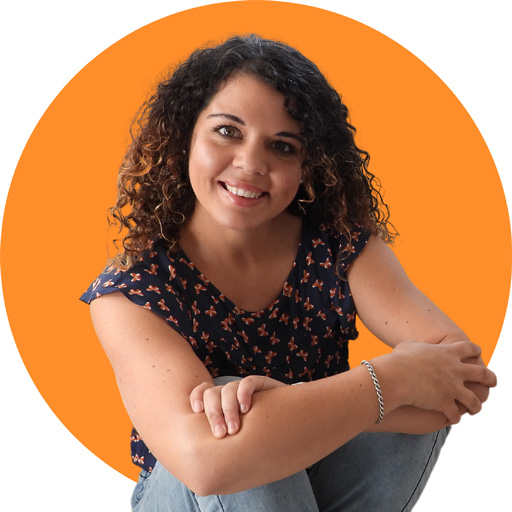
I hope you enjoy reading this blog post. If you want to do my course on how to homeschool, click here.
We’ll cover the most common homeschool methods (as well as a few obscure ones!). These include the traditional, Classical, Charlotte Mason, Unit Studies, unschooling, and eclectic methods.
(Make sure you take the free homeschool-style quiz to identify the right method for you.)

This site contains affiliate links. We sometimes receive a commission for purchases made through these links.
Traditional Homeschool Method
The traditional educational method is the one schools use. Hence it’s often called the school-at-home approach) and is the most popular method among new homeschool parents.
Traditional education uses a set curriculum that usually incorporates workbooks, spiral lessons, tests, and quizzes.
If you like this style, you can check out traditional curriculum packages:
- BJU Press curriculum (I use this one)
- Easy Peasy All In One
- Abeka Academy curriculum
Check out the video below to know more about this method.
Classical Education
Classical education is rooted in antiquity. Schools taught using the classical method until the early part of the 20th century.
Instead of getting the best test scores, classical education focuses on creating the best person.
Educators aim to create wise, virtuous, and curious pupils able to logically and critically analyze material and then present it persuasively and attractively.
Classical learning also aims to infuse students with a love of their western Christian culture, background, and foundation as they work from creating (1)wondering to (2) wise to (3) worshipping students.
Classical education teaches students according to their natural developmental stage using the trivium.
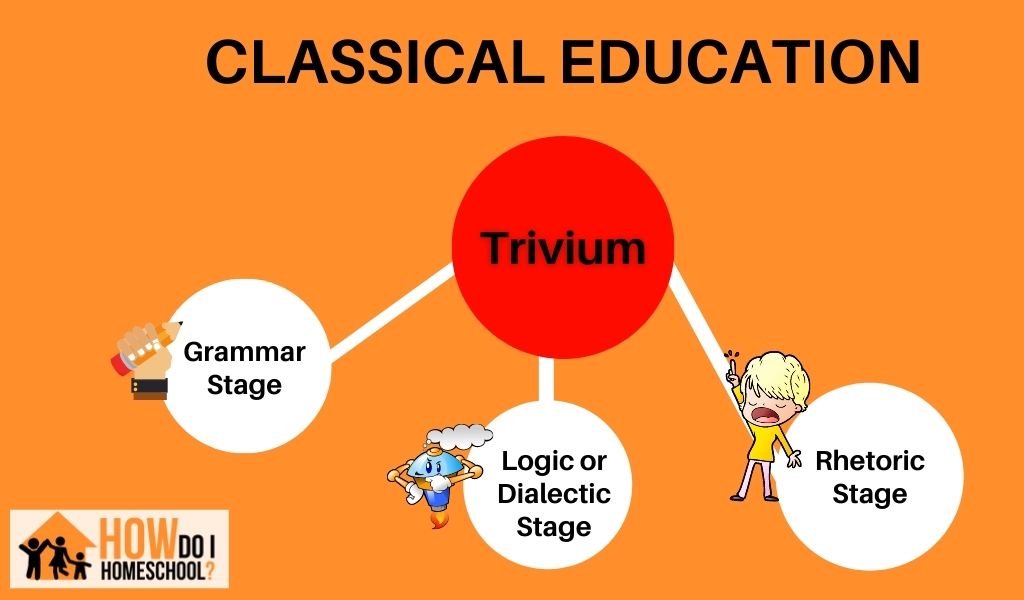
The trivium is presented in three stages:
- Grade K-4 is the grammar stage. When they’re young and love memorization and repetition, they do the grammar stage, which is all about gaining knowledge for use later on.
- Grade 5-8 is the logic stage. Now they’re asking lots of questions, and they love to argue. So they’re taught logic, debate, and critical thinking.
- Grade 9-12 is the rhetoric stage. At this age, they want to look good. Therefore, we teach them persuasion and communication.
These three stages are collectively called the trivium.
If you like the sound of this homeschooling method, check out Memoria Press which is one of the best classical curriculum programs available today.
Charlotte Mason Homeschool Method
The Charlotte Mason approach was founded by the British educator Charlotte Mason. Mason trained as a classical educator but realized the classical education methods in her time were sometimes too rigorous and monotonous. Therefore, her approach has many elements that remind you of a classical education like:
- using excellent literature sources, not dumbed-down twaddle
- teaching virtue (Mason also did this through habit training)
- giving children a love of their Christian heritage
Additionally, Mason believed educators should:
- give children a broad exposure to inspiring and exciting educational books (called living books) instead of dry textbooks
- use nature as a teacher (through nature walks and field trips). Mason founded Scouts and Girl Guides!
- only teach using short lessons but require good attention during that time
Unlike many other homeschool methods, Mason lectured homeschool mothers and homeschool tutors directly. Her advice was tailored to the homeschool environment.
For example, she believed children should learn from real-life situations and have lots of time to play and create. This makes happy learners who love learning so much that they educate themselves.
Mason also advocated testing children in a non-confrontational way. For instance, when testing comprehension of a book that a parent has just read to their child, the child should narrate (or tell back to the parent) what they have just heard.
You can check out Charlotte Mason curriculum packages here. Charlotte Mason also wrote a 5 Part series on Home Education which is widely read.
Eclectic Homeschool Method
the eclectic method is joining different parts of homeschool methods together. Do you love the Charlotte Mason method? Do you like some aspects of the classical approach? Join them together, and you have an eclectic homeschool method.
Indeed, many Christian home educators choose an eclectic approach that mixes the Classical Approach with the Charlotte Mason Educational Approach. (This is precisely what the My Father’s World and Tapestry of Grace Christian homeschool curriculum packages do.
Simples!
Unit Studies
The Unit Study homeschool method is all about connectedness. In traditional education, all the subjects are separated into their own fields. Unit Study topics incorporate all the different subjects together.
For example, if you were learning about the plagues of Egypt, you might learn about the habitat of frogs in geography. Then you might dissect a frog in science class. And so on.
This educational approach is a fantastic choice for large families. This is because you can teach all your children at once with the same Unit Studies curriculum. It’s also very hands-on, meaning younger children who struggle to sit still can learn by moving around, thereby maintaining their interest.
Older siblings also teach younger siblings with this curriculum, meaning older siblings will learn leadership skills while learning the topic particularly well.
Several curricula use the Unit Studies approach. My Father’s World and Tapestry of Grace use Unit Studies and other homeschool methods.
Many families who use Unit Study curriculum purchase separate math and language arts courses to fill a gap. However, the other subjects are covered quite well in the curriculum.
Montessori Homeschool Method
The Montessori homeschool method is self-directed, hands-on learning and collaborative play. Educators aim to develop an individual child’s strengths and interests.
Children have a closed choice of educational activities, encouraging creative learning choices and practical life skills.
Teachers or parents act as educational facilitators who can offer age-appropriate activities to guide learning. The Montessori homeschool method recognizes that children are completely capable of learning independently and don’t need to be spoon-fed titbits of information to learn.
Montessori homeschools require a special setup room with child-size furniture and Montessori activities. You can find out how to set up a Montessori house here.
You can check out a video on the Montessori homeschool method here.
Waldorf Homeschool Method
Waldorf education has grown in popularity in the last few decades. Rudolf Steiner’s education theory emphasizes educating a child holistically; mind, body, and soul.
Many things make the Waldorf homeschool method attractive such as its advocacy for hands-on, creative play and its use of a monthly learning theme, called the Main Lesson.
Some other things to note about this homeschool method are:
- it’s avoidance of technology early in children’s lives,
- storytelling (teachers memorize stories so they can relay them with eye-to-eye contact),
- the deliberate mentoring relationship teachers form with their students,
- using natural materials for play,
- there are no textbooks (instead, children make books like lapbooks to learn by)
- doing tasks as a team, and
- learning practical skills for lifelong use.
Students don’t start formal work until 6 or 7 years of age, so preschool is non-academic.
Waldorf education is based on some pretty unusual ideas, many of which stem from anthroposophy, a religious perspective Steiner believed. You can watch a video on this method below.
Unschooling/Natural Learning
Unschooling is education through daily experiences. It is one of the best ways to promote interest-based education in your homeschool! Unschooling students don’t use textbooks or a set curriculum (although they might for a period if they wanted to learn a skill).
If a child expresses an interest in learning something, parents can facilitate that learning through life.
For instance, they could go shopping and learn about:
- geography – as they learn to use the bus timetable and figure out a map
- mathematics – as they learn to add the cost of products with the amount of money they have and
- business – what’s a good deal in life and what’s not.
With the unschooling method of education, learning happens as a part of life. It is not a separate area of life where ‘now we’re learning,’ or ‘now we’re playing.’ Instead, learning in an unschooling environment happens when you live life.
The term ‘unschooling’ was coined by John Holt, a schoolteacher who became so frustrated with the school system because of its rigidity.
Consequently, Holt said unschooling should allow children as much freedom as the parents can bear so they can learn unfettered by unnecessary rules, procedures, and busywork.
Radical Unschooling
Radical Unschooling is when children are encouraged to follow their interests entirely and whole-heartedly. Parents give children complete freedom to learn what they like.
They let their children make all the decisions – no chores, no rules, no bedtime, no exams, and mealtimes. Parents don’t tell children what to eat, when to go to bed or how much television or video games they can watch.
Some claim radical unschooling is unparenting because parents, in the words of Lorraine Devon Wilke, seem to ‘abdicate their role of parents‘.
Radical Unschooling is about as ‘free’ as ‘education’ gets.
Multiple Intelligences
We all have strengths and weaknesses in specific areas. (In this theory, ‘strengths’ are called ‘intelligences.’)
Howard Gardner’s Multiple Intelligences theory says there are eight main intelligences including:
- Intrapersonal MI,
- Interpersonal MI,
- Bodily-Kinesthetic MI,
- Naturalistic MI,
- Musical MI,
- Visual-Spatial MI,
- Logical-Mathematical MI, and
- Verbal-Linguistic MI (read more about them here)
Learning can be changed according to our intelligence area.
Intelligences also differ according to our experiences and practice at strengthening different intelligences.
We could use MI to show us the easiest way to learn new concepts. This theory might also help us determine how children with special needs learn best.
This said MI is not a homeschooling method that we should base all our learning on. But, it may be used in conjunction with another approach.
Literature-Based Approach
The Literature-Based homeschool method reminds me of the classical and Charlotte Mason methods because it values using excellent and exciting books in education. Ideally, a literature-based course uses living books instead of dry textbooks.
The Sonlight and Moving Beyond the Page homeschool curricula are both literature-based.
Lapbooking
Lapbooking is a homeschooling method you’d use in conjunction with one of the other homeschooling methods (e.g. Waldorf) .
That’s because lapbooking is a little like creating an organizational system for the things you learn.
You get a big folder, and you create small books about the things you learn to go in the larger folder.
If you want to know more about this method, check out this link.
Tapestry of Grace is an example of a curriculum that uses lapbooking.
Worldschooling/Roadschooling
Worldschooling or Roadschooling is homeschooling on the road. The idea is that children gain an education from the world around them.
You learn about those areas as you travel to various places, gleaning plenty of first-hand experiences. Your senses are stimulated, and you remember the lessons you learned for life.
Students interact with the inhabitants of that region personally instead of reading about them in a book. They can see animals’ cultures, geographies and economies in person, leading to a richer and unforgettable learning experience.
The Most Popular Homeschool Methods
Out of all the home education methods, what is the most popular one? The Home Education Association (HEA) also asked this question and conducted a survey that noted the diversity of approaches and curricula choices among home learning families. They found the following:
- 31% preferred natural learning
- 27% were eclectic homeschoolers.
- 15% of families unschooled
- 11% used the Charlotte Mason approach
- 8% adopted a school-at-home approach and
- 8% used the classical approach
- [Source]
I thought these percentages accurately represented Australian parents’ choices, but I wasn’t convinced it was a good reflection of Americans. So I did a quick survey of American Christian homeschooling mums, and here were my results:

Pretty different. These results, I believe, reflect the difference between Australian and American homeschoolers. I suspect more Australians tend toward homeschooling because they have ‘hippy’ tendencies.
But, perhaps more Americans are homeschooling because they have Christian convictions. This may also explain the disparity between the number of unschoolers in the U.S. compared to Australia.
Curriculum to Follow your Homeschool Style
If you’ve decided on the homeschool method you like, you can find a curriculum to suit you based on that style. Click the style below to be taken straight to page that shows you matching curriculum:
Or you can search homeschool programs by the following:
- Popular homeschool curriculum
- High school curriculum
- Kindergarten
- Christian programs
- Cheap curricula
- FREE curricula
- Family Style homeschool curriculum
- Homeschool resources
Hope this list helps you on your way to a great homeschool!
Conclusion
People are eclectic. Therefore, we need many homeschool methods to suit our peculiar needs and preferences. My favorite is the eclectic style. If I use this method, I can choose parts of the classical, Charlotte Mason and traditional approaches that I love. I hope you’ve enjoyed this article! If you want to know more about how to homeschool, see my guide!
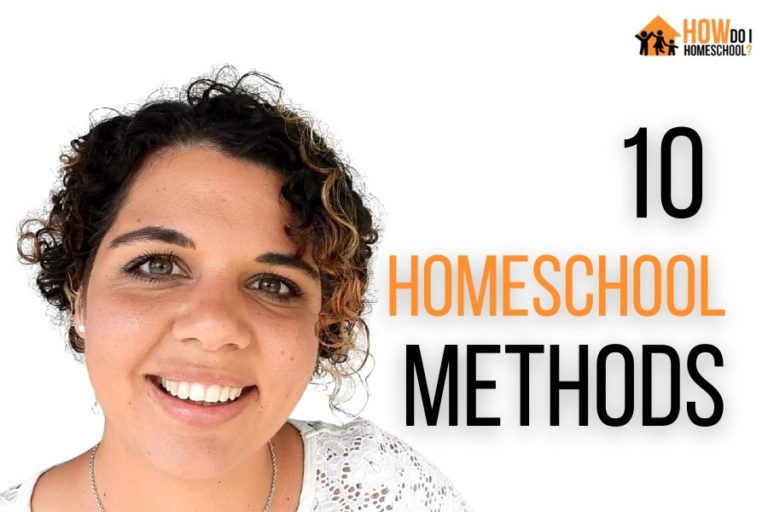
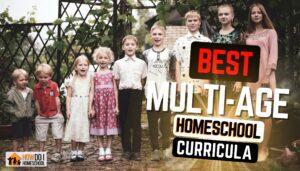
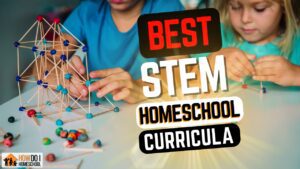

The Grammar stage, the logic stage, and the rhetoric stage. In my opinion the human brain can recognize, adapt, and pick up on things at a much faster pace then the pace set by the school boards.
Absolutely. I love classical education.
Rebecca, I just added a link to this article to the “Homeschool Hints” page of our website, along with a general link to your website. Thanks for the great information! I thought it would help our readers a lot!
Here’s the link to where we’re featuring you: https://characterbuildingforfamilies.com/hints/
Thanks again!
Lee Ann
Character Building for Families